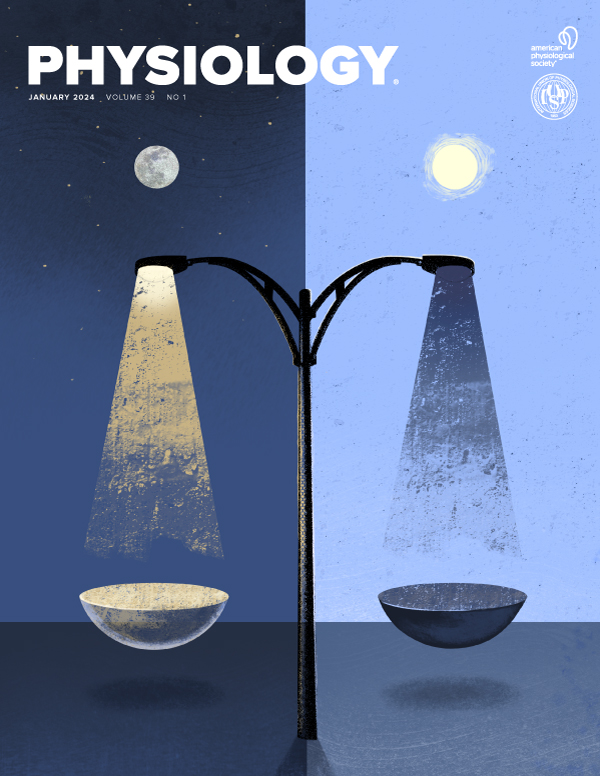比较年轻小鼠和老年小鼠的骨骼肌转录组与年轻人类和老年人类的骨骼肌转录组在急性偏心收缩时的变化
IF 5.3
2区 医学
Q1 PHYSIOLOGY
引用次数: 0
摘要
阻力运动会改变骨骼肌中的一些分子事件,从而改变肌肉的大小和功能,包括改变转录组。改变肌肉转录组以应对阻力运动的信号仍不明确。要确定肌肉中的这些调控信号,需要建立非人类模型,通过操作来评估因果关系。啮齿类动物的电诱导单侧偏心收缩阻力运动模型被广泛用于模拟阻力运动。然而,啮齿类动物模型对偏心收缩所产生的转录变化以及啮齿类动物模型与人类阻力运动的连续性并不十分清楚。本研究的目的是确定幼鼠和老龄小鼠骨骼肌在急性偏心收缩时发生的转录变化,并确定其与人类幼鼠和老龄小鼠肌肉转录变化的连续性。对4个月大和24个月大的雄性C57BL/6小鼠的胫骨前肌(TA)进行一轮电诱导的单侧偏心收缩。从胫骨前肌分离出 RNA 并进行 RNA 测序。将年轻小鼠和老年小鼠胫骨前肌的差异表达基因(DEGs)列表与急性偏心收缩后从年轻人和老年人腓肠肌中生成的 RNA 测序数据集进行比较。采用L andscape I n S ilico deletion A nalysis(Lisa)预测DEGs受转录因子调控的程度。小鼠或人类的 DEGs 被分为年龄特异性 DEGs(年轻人或老年人的特异性 DEGs)或两个年龄段共有的 DEGs。小鼠或人类的 DEGs 数量在每个类别中的分布相同,显示出小鼠和人类的年龄特异性分布是一致的。然而,年轻小鼠和老年小鼠的 DEGs 与年轻人类和老年人类的 DEGs 几乎没有重叠。只有 113 个 DEGs 在所有年龄段和物种中具有共性。有趣的是,年轻小鼠和老年小鼠或年轻人类和老年人类之间预测调控 DEGs 的转录因子之间的关系非常密切。然而,预测调控年轻小鼠和年轻人类或老年小鼠和老年人类 DEGs 的转录因子之间的关系却相当弱。总之,这些数据凸显了肌肉转录组对偏心收缩反应的一致性和差异性。本研究部分由美国国立卫生研究院 R03AG073445(BSG)资助。本文是在 2024 年美国生理学峰会上发表的摘要全文,仅提供 HTML 格式。本摘要没有附加版本或附加内容。生理学》未参与同行评审过程。本文章由计算机程序翻译,如有差异,请以英文原文为准。
Comparing changes to the skeletal muscle transcriptome of young and aged mice to young and aged humans in response to acute eccentric contractions
Resistance exercise alters several molecular events in skeletal muscle that change muscle size and function, including changes to the transcriptome. The signals altering the muscle transcriptome in response to resistance exercise remain ill defined. Defining those regulatory signals in muscle requires non-human models where manipulations can assess cause and effect. The electrically induced, unilateral eccentric contraction model of resistance exercise in rodents is widely used to mimic resistance exercise. However, the transcriptional changes that occur in response to eccentric contractions in the rodent model and the continuity of the rodent model to resistance exercise in humans are not well known. The purpose of this study was to define the transcriptional changes in skeletal muscle that occur in response to acute eccentric contractions in young and aged mice and define their continuity to transcriptional changes in the muscle of young and aged humans. Four-month-old and 24-month-old male C57BL/6 mice were subjected to a bout of electrically induced, unilateral eccentric contractions of the tibialis anterior (TA) muscle. RNA was isolated from the TA and subjected to RNA Sequencing. Lists of differentially expressed genes (DEGs) from the TA of young and aged mice were compared to RNA Sequencing datasets generated from the vastus lateralis muscle of young and aged humans following acute eccentric contractions. L andscape I n S ilico deletion A nalysis (Lisa) was used to predict the magnitude of transcription factor regulation of the DEGs. DEGs for mice or humans were categorized into age specific DEGs (specific to young or aged) or DEGs shared by both ages. The number of DEGs for mice or humans were distributed equally to each category, showing an age specific distribution that was conserved in both mice and humans. However, the DEGs in young and aged mice had very little overlap to the DEGs in young and aged humans. Only 113 DEGs were common across all ages and species. Interestingly, the relationship of transcription factors predicted to regulate DEGs between young and aged mice or young and aged humans was very strong. However, the relationship of transcription factors predicted to regulate DEGs of young mice and young humans or aged mice and aged humans was rather weak. In all, these data highlight the consistencies and differences in the muscle transcriptomic response to eccentric contractions. This work was supported in part by NIH R03AG073445 (BSG). This is the full abstract presented at the American Physiology Summit 2024 meeting and is only available in HTML format. There are no additional versions or additional content available for this abstract. Physiology was not involved in the peer review process.
求助全文
通过发布文献求助,成功后即可免费获取论文全文。
去求助
来源期刊

Physiology
医学-生理学
CiteScore
14.50
自引率
0.00%
发文量
37
期刊介绍:
Physiology journal features meticulously crafted review articles penned by esteemed leaders in their respective fields. These articles undergo rigorous peer review and showcase the forefront of cutting-edge advances across various domains of physiology. Our Editorial Board, comprised of distinguished leaders in the broad spectrum of physiology, convenes annually to deliberate and recommend pioneering topics for review articles, as well as select the most suitable scientists to author these articles. Join us in exploring the forefront of physiological research and innovation.
 求助内容:
求助内容: 应助结果提醒方式:
应助结果提醒方式:


